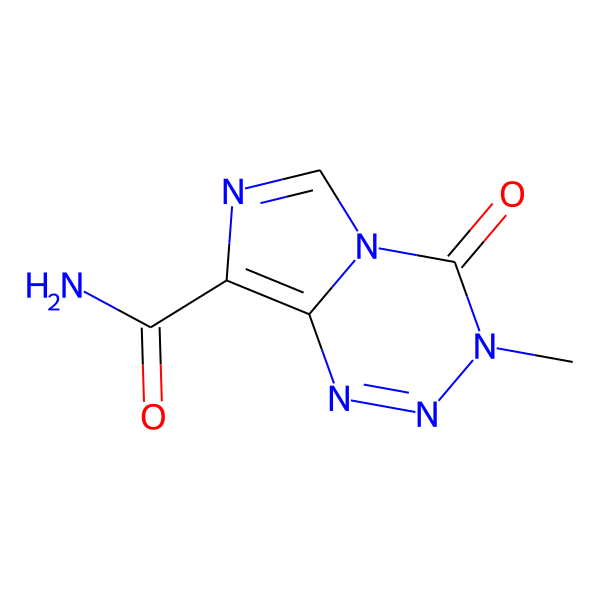Temozolomide
Function
DrugBank ID:
Description:
Refractory anaplastic astrocytoma (WHO grade III) and Glioblastoma multiforme (WHO grade IV) are primary malignant brain tumours with poor prognosis and limited treatment options. Despite considerable genetic heterogeneity, these tumours often have impaired DNA repair systems, rendering them initially sensitive to alkylating agents, although they invariably develop resistance to these agents over time.Temozolomide is an imidazotetrazine prodrug that is stable at acidic pH but undergoes spontaneous nonenzymatic hydrolysis at neutral or slightly basic pH; these properties allow for both oral and intravenous administration.Following initial hydrolysis, further reactions liberate a highly reactive methyl diazonium cation capable of methylating various residues on adenosine and guanine bases leading to DNA lesions and eventual apoptosis.Temozomolide as an adjunct to radiotherapy followed by maintenance dosing remains the standard of care for both Glioblastoma and refractory anaplastic astrocytoma.Temozolomide was granted FDA approval on August 11, 1999, as an oral capsule and subsequently on February 27, 2009, as an intravenous injection. It is currently marketed under the trademark TEMODAR® by Merck. [DrugBank]
Targets:
DNA (Humans) [DrugBank]
Pharmacodynamics:
Temozolomide is a prodrug of the imidazotetrazine class that requires nonenzymatic hydrolysis at physiological pH in vivo to perform alkylation of adenine/guanine residues, leading to DNA damage through futile repair cycles and eventual cell death. Temozolomide treatment is associated with myelosuppression, which is likely to be more severe in females and geriatric patients. Patients must have an ANC of ≥1.5 x 109/L and a platelet count of ≥100 x 109/L before starting therapy and must be monitored weekly during the concomitant radiotherapy phase, on days one and 22 of maintenance cycles, and weekly at any point where the ANC/platelet count falls below the specified values until recovery. Cases of myelodysplastic syndrome and secondary malignancies, including myeloid leukemia, have been observed following temozolomide administration. Pneumocystis pneumonia may occur in patients undergoing treatment, and prophylaxis should be provided for patients in the concomitant phase of therapy with monitoring at all stages. Severe hepatotoxicity has also been reported, and liver testing should be performed at baseline, midway through the first cycle, before each subsequent cycle, and approximately two to four weeks after the last dose. Animal studies suggest that temozolomide has significant embryo-fetal toxicity; male and female patients should practice contraception up to three and six months following the last dose of temozolomide, respectively.17 [DrugBank]
Structures
Docking in target protein
Off-target analysis based on ligand similarity (Homo sapiens)
Step 1 - Target prediction for Temozolomide: SwissTargetPrediction
Tips: Click on the link to jump to the 'SwissTargetPrediction' webserver. Select the species of 'Homo sapiens', and then paste the SMILES of Temozolomide in the SMILES input box.
Step 2 - Blind docking for Temozolomide: CB-Dock
Tips: Click on the link to jump to the 'CB-Dock' webserver. Upload the structure file of target predicted by 'SwissTargetPrediction' and the 2D/3D structure file of Temozolomide to perform blind docking.
